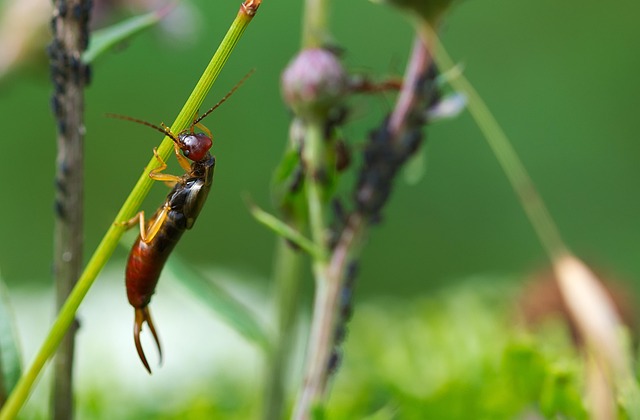Earwigs, though not directly harmful to humans, are considered nuisances due to their feeding habits and preference for dark, moist environments. Commercial spaces vulnerable to infestations include food processing plants and recycling centers. Extermination strategies involve targeting hiding places, eliminating moisture sources, and using specialized treatments that disrupt communication and feeding patterns without harming non-target species or the environment. Early detection, regular maintenance, sealing entry points, and minimizing moisture levels are key preventative measures. A multi-faceted approach combining chemical and natural insecticides, baits, vacuuming, and mechanical methods ensures effective commercial earwig extermination while minimizing environmental impact.
Understanding earwig behavior is key to effective pest control, especially in commercial spaces. This article delves into the intricate world of these insects, exploring their lifestyle and habits. We’ll guide you through identifying earwig breeding grounds, providing insights on common extermination methods, and offering long-term preventative measures for robust commercial earwig control. By implementing these strategies, businesses can create an inhospitable environment for earwigs, ensuring a peaceful and pest-free workplace.
Earwigs: An Overview of Their Lifestyle and Habits
Earwigs are a common pest that, despite their intimidating name, pose little direct threat to humans. They primarily feed on decaying plant material and small insects, making them more of a nuisance than a danger. Understanding their behavior is crucial for effective commercial earwig extermination strategies. These nocturnal creatures prefer dark, damp environments, often hiding in cracks, crevices, and plant debris during the day. At night, they emerge to forage for food, seeking out moist areas where they can find their preferred fare.
Earwigs are social insects that live in colonies, with each colony specializing in different roles like foraging or guarding. While they don’t leave trails of pheromones like ants do, they use a system of visual and olfactory cues to communicate within their groups. Commercial earwig extermination requires addressing these behaviors by targeting hiding places, eliminating moisture sources, and using specialized treatments that disrupt their communication and feeding patterns without harming non-target species or the environment.
Identifying Earwig Breeding Grounds in Commercial Spaces
Earwigs are often overlooked pests, but they can thrive in various environments, including commercial spaces. Identifying their breeding grounds is a critical step in effective earwig extermination. These insects are attracted to moist, dark areas with easy access to plant matter, making them common in commercial settings like greenhouses, gardens, and landscapes. They nest in cracks, crevices, and under debris, so regular inspections should focus on these spots.
Commercial spaces with organic waste, such as food processing facilities and recycling centers, are particularly vulnerable. Earwigs breed rapidly, so early detection is essential. Professional pest control services use specialized techniques to locate and eliminate earwig populations, including the inspection of baseboards, behind appliances, under flooring, and in storage areas. Regular maintenance, proper sealing of entry points, and minimizing moisture levels can also significantly reduce the risk of earwig infestations.
Common Methods for Commercial Earwig Extermination
Commercial earwig extermination often involves a combination of strategies tailored to the specific needs and scope of the infestation. One common method is the use of insecticides, both chemical and natural, that target earwigs directly. These substances are applied in strategic locations where earwigs tend to congregate, such as around entry points, under debris, and in dark corners. Professional pest control services often opt for low-toxicity options to minimize environmental impact while ensuring the effectiveness of treatment.
Another effective approach is the utilization of baits, which lure earwigs with attractive substances that they cannot resist. Once trapped, these baits eliminate the pests without causing harm to surrounding environments or non-target organisms. Additionally, mechanical methods like vacuuming and physical removal play a role in commercial earwig extermination by swiftly addressing visible populations and disrupting their breeding grounds. These multifaceted strategies work synergistically to provide lasting solutions for commercial earwig extermination.
Preventative Measures: Long-term Strategies for Earwig Control
Preventative measures are key to long-term earwig control, especially in commercial settings. Implementing a robust pest management strategy involves creating an environment that discourages earwig infestation. This includes regular inspections to identify and seal entry points, as earwigs are known to crawl through tiny cracks and gaps. Maintaining a clean and tidy space is crucial; eliminating sources of moisture and organic debris reduces attraction and nesting sites.
For commercial earwig extermination, professionals often recommend combining physical barriers with chemical treatments. Installing screens on windows and doors, sealing vents, and applying appropriate insecticides can disrupt earwig populations. Regular treatment plans should be established, focusing on areas where earwigs are known to gather, such as dark, humid corners or near water sources.
Understanding earwig behavior is key to effective commercial earwig extermination. By identifying their breeding grounds and implementing targeted strategies, businesses can mitigate these pests’ presence. Combining preventive measures with robust extermination methods ensures a long-term solution, creating an environment that discourages earwigs from returning. For successful commercial earwig control, knowledge and proactive steps are the best weapons.
